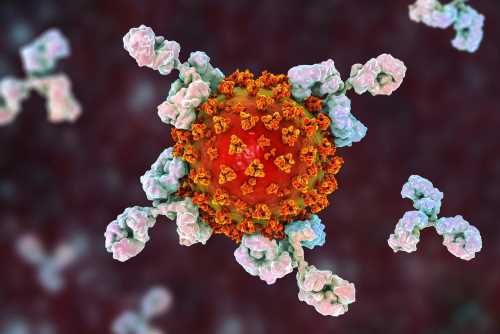In a recent article published in Scientific Reports, researchers performed an observational study among coronavirus disease 2019 (COVID-19) patients and their close contacts registered with the Bangkok home health care services in Thailand. They assessed their T-cell and neutralizing antibody responses six months after exposure to severe acute respiratory syndrome coronavirus 2 (SARS-CoV-2).

Background
Antibodies eBook

By late 2022, 75% of Thailand's population had been vaccinated, mostly with viral vector and messenger ribonucleic acid (mRNA)-technologies-based COVID-19 vaccines. Yet, the SARS-CoV-2 Omicron variant infected 5% of the country's population, but thankfully the death rate was lower than the observed death rate during Delta predominance era (120 vs. 300 per day).
Researchers expected people in Thailand would develop herd immunity following mass vaccination via vaccine- or prior infection-induced hybrid immunity against SARS-CoV-2 infection. They also hypothesized that the lower death rate during the 2022 Omicron outbreak in Thailand might have been due to herd immunity, hybrid immunity, and the lower virulence of Omicron.
Moreover, close contacts of infected cases developed T-cell immunity against SARS-CoV-2, which kept COVID-19-related death rates in Bangkok low, even among cases treated at home care centers. However, reluctance to receive the vaccine and the advent of new immune-evading SARS-CoV-2 variants hindered meeting the herd immunity threshold.
About the study
In the present study, researchers collected blood samples from all 79 participants from 15 families invited randomly from different metropolitan areas of Bangkok. Of these, 34 individuals had recovered from SARS-CoV-2 approximately four weeks before recruitment into this study, whereas 45 COVID-19 cases were their close contacts.
A minimum of one SARS-CoV-2-infected patient in each participating family had to be a registered member of a home health care center in Bangkok between 1 and 31 August 2021, having at least one asymptomatic close contact living in the same care center. The researchers analyzed the T-cell response using an enzyme-linked immunosorbent spot (ELISpot) assay.
Study findings
During SARS-CoV-2 exposure, COVID-19 patients and their close contact(s) in each family coinhabited the same healthcare home, with an area of approximately 200 m2. The study population comprised 15 families with 11 members in each family, and 58% were females. Over 90% of members were under 60, and 81% had a body mass index (BMI) of less than 30. In addition, one-fifth of the study participants, 26.5% of the patients and 15.5% of their close contacts, had comorbidities that increased their risk of progression to severe COVID-19.
The researchers observed a positive T-cell response to the Neuromyelitis Optica (NMO) antigen in 11 of 45 cases, i.e., 24.4% of close contacts, indicating prior infection. Strikingly, these 11 cases that exhibited T-cell responses were most likely asymptomatic.
Furthermore, the researchers noted a substantial drop in receptor-binding domain (RBD) immunoglobulin G (IgG) levels of unvaccinated patients at six months after SARS-CoV-2 exposure, and that of close contacts was comparable. Interestingly, RBD IgG levels increased in a dose-dependent way, but the T-cell response did not, a state termed "T-cell exhaustion."
Conversely, the researchers noted a decrease in T-cell responses against the S antigen increased as vaccine doses, i.e., with the third or fourth booster. Thankfully, studies have demonstrated T-cell responses against the SARS-CoV-2 Omicron variant rapidly reactivated three months after boosting. Vaccine type might have confounded these responses.
Notably, 75% of the study participants had received an inactivated or viral vector vaccine approximately three-and-a-half months before recruitment into this study. On the other hand, less than one-third of the participants had received a booster dose of an mRNA vaccine around a month before study recruitment. Therefore, clinicians should closely monitor infection early after boosting and administering multiple vaccine doses with special considerations, especially in cases with a poor T-cell response.
Conclusions
Overall, the observed T cell and antibody responses indicated hybrid immunity among vaccinated patients with prior SARS-CoV-2 infection and herd immunity among unvaccinated patients with prior COVID-19. Likewise, vaccinated close contacts with no history of COVID-19 had herd immunity.
Most importantly, nine unvaccinated close contacts also showed a T-cell response against the SARS-CoV-2 spike (S) antigen. Perhaps, they developed herd immunity from an episode of asymptomatic infection. More importantly, with reduced neutralizing antibodies against the Omicron variant, a T-cell-based vaccine is needed that could generate diverse memory B cells against SARS-CoV-2.
- Chevaisrakul, P. et al. (2023) "Hybrid and herd immunity 6 months after SARS-CoV-2 exposure among individuals from a community treatment program", Scientific Reports, 13(1). doi: 10.1038/s41598-023-28101-5. https://www.nature.com/articles/s41598-023-28101-5
Posted in: Medical Science News | Medical Research News | Disease/Infection News
Tags: Antibodies, Antibody, Antigen, Assay, Blood, Body Mass Index, Cell, Coronavirus, Coronavirus Disease COVID-19, covid-19, Enzyme, Exhaustion, Health Care, Healthcare, Home Care, immunity, Immunoglobulin, Neuromyelitis optica, Omicron, Receptor, Respiratory, Ribonucleic Acid, SARS, SARS-CoV-2, Severe Acute Respiratory, Severe Acute Respiratory Syndrome, Syndrome, T-Cell, Vaccine, Viral Vector

Written by
Neha Mathur
Neha is a digital marketing professional based in Gurugram, India. She has a Master’s degree from the University of Rajasthan with a specialization in Biotechnology in 2008. She has experience in pre-clinical research as part of her research project in The Department of Toxicology at the prestigious Central Drug Research Institute (CDRI), Lucknow, India. She also holds a certification in C++ programming.
Source: Read Full Article
